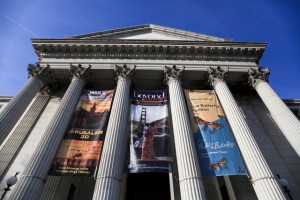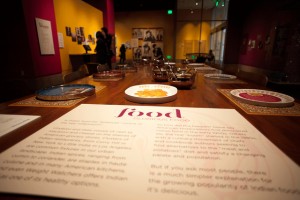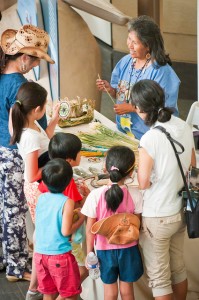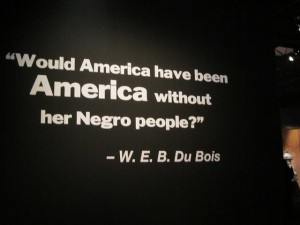Beyond fifteen minutes of fame
26 November 2014 – Priya Chhaya

Banner outside the National Museum of Natural History. Photo Credit: US Department of State on Flickr, Creative Commons.
Earlier this year the Indian American Heritage Project at the Smithsonian launched its inaugural exhibition Beyond Bollywood. Housed in a gallery at the National Museum of Natural History through March 2015, the exhibition “explores the heritage, daily experience and numerous, diverse contributions that Indian immigrants and Indian Americans have made to shaping the United States.” For the last year I’ve been involved peripherally with the exhibition, as a contributor to the Beyond Bollywood blog.
There are a lot of things that this exhibition has going for it. It’s located in a high traffic museum, and it embeds the experiences of Indian immigrants and Indian Americans in a context filled with music, photographs, and art. The exhibition has spurred pride, excitement, and interest. However, it has also spun out into a broader discussion about representation and identity.
For some, Beyond Bollywood is fantastic. Its very existence demonstrates that Indian Americans are a part of the broader American story. Visitors come through the doors and find pieces of themselves in the music, art, and narratives, as reflected in these tweets about the exhibit:
Papa Patel and little broski are going #beyondbollywood and I’m having so many feelings y’all
— Viraj (@virajspatel) June 18, 2014
Saw the amazing #beyondbollywood exhibit at the @NMNH – Anybody who comes from immigrant parents should make the trip
— Pooja Kobawala (@Brooklynpbjs) October 5, 2014

A look at the inside of Beyond Bollywood. Photo credit: US Department of State on Flickr, Creative Commons
For others, the exhibition does not go far enough. They want more nuance, something that digs more deeply into what it means to be Indian American instead of an introductory exhibit that some see as merely a starting point. There is concern that by highlighting individual accomplishments, the exhibition diminishes the whole and does not represent a complex community writ large. Some see in celebration an advancement of the age-old conversation about the model minority–the idea that minority cultures have to represent themselves in a positive light, as success stories. Critics have even asserted that we have reached a point where the idea of seeing ourselves as Indian [hyphen] Americans is an antiquated notion.
In the last several decades, the telling of American history has changed. As exhibitions and the academy moved from white-male-centric views of history, many museums have successfully begun including Asian, African American, Latino, and other minority stories in their public programming. During the same time period, many groups have created (or are in the process of creating) their own museums–the future National Women’s History Museum, the National Museum of African American History and Culture, the Museum of Chinese in America in New York, or the Wing Luke Museum in Seattle, for example. Unfortunately we still have a lot of work to do, as sometimes telling diverse stories lacks consistency and is often perceived as tokenism, i.e. just including an example to say you did.
While I recognize that Beyond Bollywood is imperfect–and in some ways reflects conventional celebratory patterns–I still see it as opening new and valuable opportunities.
First, the exhibit provides an introduction to histories and cultures that are not necessarily familiar to Americans. Many visitors arrive at the exhibit without any context and are encountering these stories for the first time. For these visitors, Beyond Bollywood opens a gate by providing familiar touchstones to contextualize how South Asian immigrants came to America and some of what we have made of ourselves since. Granted the exhibition does not, as Aseem Chhabra and S. Mitra Kalita say in their reviews, touch on shortcomings as well as successes, but it does provide an introduction to our past and present in the United States. The exhibition looks at stereotypical occupations for Indian Americans–the doctor, the taxi cab driver, the motel owner–and allows for visitors to get a cursory glance at individuals amidst the stock figures.

The National Museum of the American Indian holds extensive programming, such as the annual Living Earth Festival pictured here, that supplements the permanent exhibition. Photo credit: Ernest Amoroso, July 2011, NMAI via Flickr, Creative Commons.
The difficulty with this strategy is that by using the broad strokes version of history, you lose the complexity of human experiences. I remember visiting the permanent exhibition at the National Museum of the American Indian for the first time and getting that almost white-washed sense. The exhibition looks at Native Americans from a global perspective, using broad strokes to tell a unifying story despite the intricate and distinct narratives that existed from tribe to tribe and community to community. But the purpose of these exhibitions is to be introductory–to capture the attention of visitors who are stepping inside for sometimes no more than 10 minutes. Too much detail will turn them away without gaining even the cursory knowledge of how these stories fit into the well-versed history that they receive in other ways.
The tension between the broad brush and the fine grain also came through in Edward Rothstein’s 2009 review of Tavis Smiley’s America I Am exhibition, an examination of African American experiences in the United States which ran for four years and toured many major cities. “What the exhibition does present is a basic primer, which will, perhaps, serve as a popular introduction,” Rothstein wrote. ”The problem is that most of the history here is so well known in outline that it could serve as the foundation for a show rather than its main point, a frame for explanation rather than the object of attention.”

Opening Banner for America I Am Exhibition. | Credit: urbanbohemian on Flickr via Creative Commons.
Rothstein’s words emphasize the transitions that our historical narratives go through in the public sphere. At what point do we move beyond the introductions–and when we do, how do we reach the point of just becoming part of “American history” rather than a subaltern sub-section of it? As Nina Simon asked recently on Museum 2.0, how can we go from being “multicultural” to being “intercultural”–and how do we know when that’s the best strategy to pursue? Like other minorities in America, South Asians are struggling with these questions in relation to museum exhibits and many other facets of culture.
Even if it just represents an early step in this struggle, I do see opportunities in the Beyond Bollywood exhibition. Its presence in one of the nation’s most visible museums can potentially serve as a galvanizing moment of self-reflection not just for Indians but more generally for South Asians in the US. The exhibition is more than an acknowledgement, a symbol, that our stories do have a place in the larger narrative of the American past. It provides an actual place for us to stand up and say, “This is just one piece of the story we want the world to know. There is more to us than one exhibition.” The missing pieces can be further presented in community museums, online galleries, and art exhibitions. And in a world where social media is widespread, South Asians and others can also engage with our past on YouTube, Facebook, and Twitter. (A great example of a group doing this directly using digital media is Reclaiming Identity: Dismantling Arab Stereotypes).
Some of this is already happening (for example, collecting efforts via the South Asian Digital Archive). But bringing the conversation to a larger stage expands the opportunity for growth exponentially. The effects of this exhibition can be anything but fleeting. It’s a step that will allow us to push our stories–both the good and the bad–farther into the public sphere, helping to redefine our place in American history.
~ Priya Chhaya is a public historian whose day job involves working on online content for the National Trust for Historic Preservation. Follow her @priyastoric and at www.priyachhaya.com.



